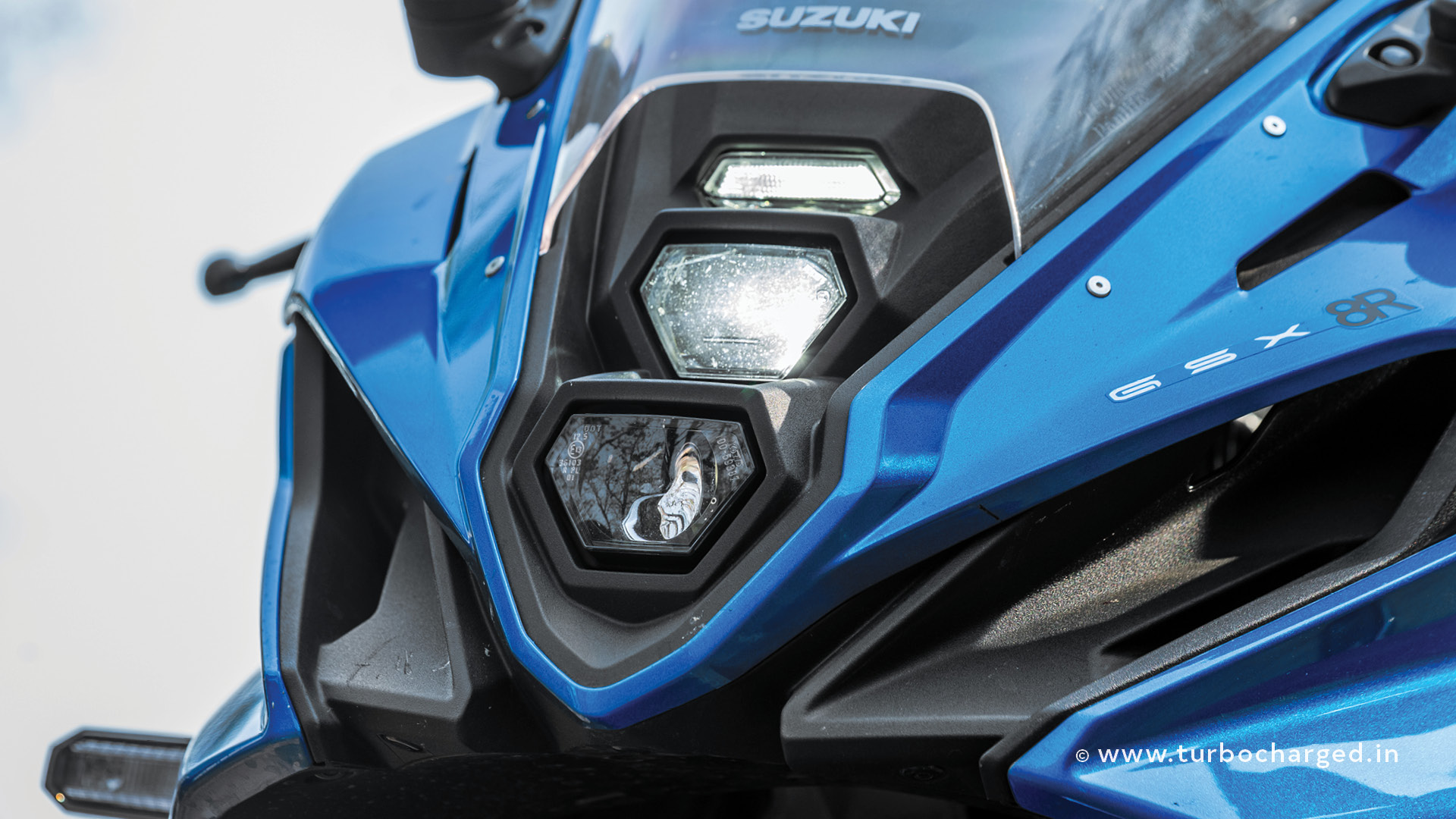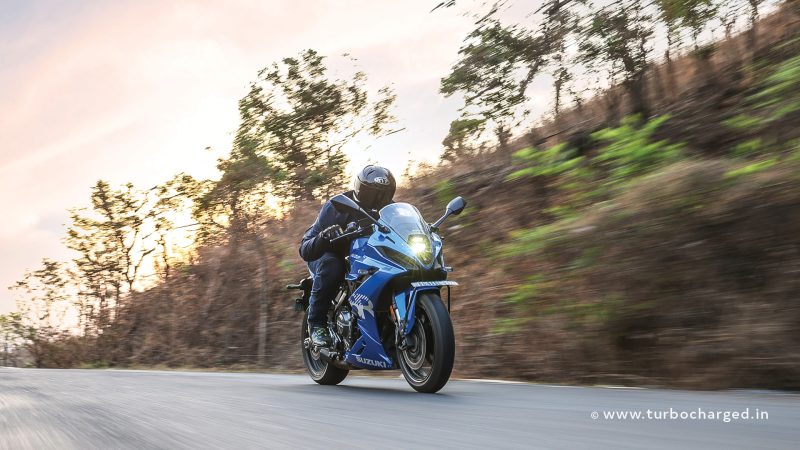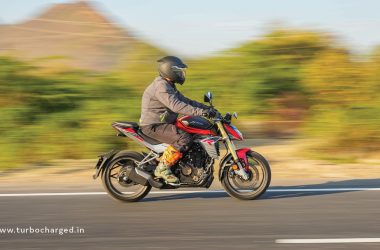Words Abhay Verma | Photography Akshay Jadhav, Saidatta Naik
Like the Ducati Panigale, I’ve a bit of a ‘throwback’ for the Suzuki GSX-8R too. Back in August 2010, I was testing the Suzuki GSX-R1000 and found myself in awe of the bike quickly. That’s courtesy its mind-numbingly quick acceleration and engine refinement yes, but more importantly, the charisma of its inline four-cylinder engine and the banshee-like wail. A few years later I tested the 2018 GSX-R1000 at the Madras International Circuit extensively, which only had the GSX-R endear itself to me further, given the ease with which you could ride it fast around the racetrack. So, with Japanese litre-class machines and their brilliant inline four-cylinder engines teetering on the brink of extinction, I’ve been a little glum.

Heck, Japanese sportsbikes are becoming a rarity – we only have a handful of fully-faired machines from the land of the rising sun on sale in India. The Suzuki GSX-8R certainly comes across as a breath of fresh air thus. It may not be powered by an inline four-cylinder engine, something we all innately associate with sportsbikes, but does that mean it is not as visceral to ride, because its engine has only half the number of cylinders? But before we get to that, a bit of trivia about the bike’s name, as the 8R does use Suzuki’s hallowed GSX nomenclature, but with a clever differentiation. With this new format Suzuki does not use the full engine displacement in the name as it has traditionally, like in the GSX-R600, GSX-S750 and even the big daddy, the GSX-1300R Hayabusa.

In fact, the GSX-8R is the only Suzuki besides the mighty falcon to not have an alphabet precede the number in its name! Talking about numbers, the 8R is powered by the same 776cc, liquid-cooled parallel-twin cylinder engine as the V-Strom 800DE, but in a slightly higher state of tune. You get 82PS produced at just 8,500rpm, and 78Nm that’s available from merely 6,800rpm – very un-sportsbike-like. The engine is mated to a six-speed gearbox. You also get Suzuki’s usual list of rider aids including three riding modes, A, B and C, along with multiple traction control levels. A 5.0-inch, colour TFT display offers a lot of information and thankfully, unlike the Europeans, Japanese manufacturers ensure you can read it all in a neat and legible manner, even when riding fast.

The GSX-8R and its naked sibling sold abroad, the GSX-8S, are underpinned by what is perhaps Suzuki’s first all-new sportsbike platform in eons. The bike uses a bolt-on rear subframe, while the chassis is a steel unit and the swingarm an asymmetrical one. The 8R is suspended on Showa’s separate function, big piston upside down forks at the front, while a monoshock with a linkage performs duty at the rear. The wheelbase is 1,465mm, while seat height is reasonably low at 810mm for a sportsbike. The 8R is also reasonably light for a middleweight sportsbike, tipping the scales at 205kg, all fluids in.

It also looks pretty compact and is probably just slightly larger than a KTM RC390 visually, which is pretty awesome. Partly, the compactness is courtesy the parallel-twin cylinder engine, a format that helps manufacturers lots of space when developing a motorcycle. This holds particularly true when compared to V-twin engines, which essentially are two large blocks of metal sitting opposed to each other under the fuel tank. And this is the space where manufacturers can fit in a lot of electricals and auxiliary systems. Of course, V-twins have their own advantage, like their superior soundtrack besides the performance, but new-age parallel-twin engines like the 8R’s use a 270-degree crank configuration which helps it sound very good too.

The bike’s design reminds of Suzuki’s GSX-R series of sportsbikes, but the vertically stacked dual projectors sitting exposed help the 8R look bolder. The 14-litre fuel tank looks small, while the stepped seat helps in completing the sportsbike look. The raised clip-on handlebars ensure the riding position isn’t too committed, adding a big dollop of practicality, along with the not-so-rear-set footpegs. Overall, this is a very appealing looking machine, especially from the front three-quarter. Closer inspection helps assert the fact that it is also a well-built, high quality Japanese sportsbike given the quality of plastics, be it the body panels or switchgear, while also offer a very tactile feel. Fit-finish levels are very premium and the paint sheen excellent to say the least.

The 270-degree crank has the 8R sound like and remind of Ducatis, besides which the 8R’s exhaust note also adds more character. Fuelling is very crisp, typical of a Suzuki, and throttle responses, especially in A mode, are very sharp. The 8R is thus anything but ‘boring’, a term commonly used for sportsbikes powered by parallel-twin engines. Another advantage over inline four-cylinder engines is that the engine doesn’t need to be high strung – you don’t need to rev it to the moon to get into the meat of the powerband, as there’s lots of shove at low to mid revs. This makes for a playful nature, especially when riding in the hills.

There’s plenty of grunt out of corners and gear ratios are adequate, helping you pick the right gear for a corner easily. The suspension offers a firm feel that helps the Suzuki impress around corners with its ability to hold a line, and breaking into a smile as you nail corner after corner effortlessly is a given. The bike is a perfect example that you don’t need a ridiculously fast sportsbike with trick suspension to have fun around bends. The GSX-8R breaks a lot of conventions thus, feeling relatively ‘ordinary’ on paper but delivering in heaps on the performance, engine refinement and handling front in the real world. It lives up to the expectations and benchmarks set by sportsbikes born out of Hamamatsu, and is a corner-carving tool that’s also surprisingly practical.

I rode the bike down from Mumbai to Pune and the three-hour ride felt effortless thanks to the taller handlebars and excellent seat comfort. The suspension soaks up undulations well, helping the 8R offer a fine balance between sporty handling and a comfortable ride quality. The bike is easy to ride and surprisingly light and agile in traffic too, thus feeling apt as an everyday sportsbike. Electronics work brilliantly and overall, there’s the trademark Japanese clinical precision to the way the GSX-8R functions and performs, no matter where you ride it. The 310mm dual discs offer good bite along with a progressive feel, be it when tapping lightly in traffic or braking hard for a corner in the hills.

In a nutshell, there’s a lot to like about the Suzuki GSX-8R once you look beyond the traditional sportsbike recipe of fast lap times, a screaming inline four engine redlining at 14,000rpm and a riding position that threatens to leave you with a backache anywhere outside a racetrack. It’s ex-showroom price of Rs 9.25 lakh sounds reasonable too, once you look at what you’re getting for the price in terms of the build quality, the handling, comfort and overall practicality. Should be interesting to see how inline-four-obsessed Indian buyers respond!










